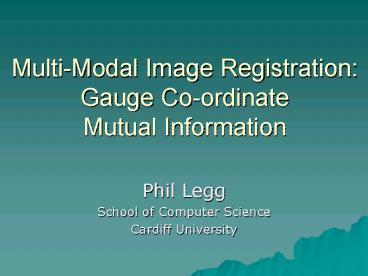Image Registration using Mutual Information - PowerPoint PPT Presentation
1 / 22
Title: Image Registration using Mutual Information
1
Multi-Modal Image RegistrationGauge Co-ordinate
Mutual Information
Phil Legg School of Computer Science Cardiff
University
2
Contents
- Introduction
- Mutual Information
- Gauge Co-ordinates Feature Derivatives
- Incorporating Features with Mutual Information
- Results
- Future Work
3
Introduction
- My Aim Successfully register multi-modal images.
(e.g. Retinal images)?
4
What is the problem?
- Images of different modalities may have little or
no distinct intensity relationship. - Many possible transformation to be considered
- Translation
- Rotation
- Scale
5
Introduction to Mutual Information
- A comparison of statistical dependence between
two images by measuring the spread of data. - Essentially a measure of how well one image
predicts the other. - Allows mapping of different intensities for
feature representation. - Ideal for Multi-Modal images.
6
Mutual Information Formula
I(A,B) H(A) H(B) - H(A,B)?
- H(A) entropy of template
- H(B) entropy of overlap ref. image
- H(A,B) joint entropy
- We wish to maximise I(A,B) to find the most
suitable registration.
7
Problem?
- Mutual Information gives poor results for our
data... - Intensity relationship is too weak for MI to cope
with - Little spatial information considered by MI
8
Successful Results
9
Unsuccessful Results
10
Gauge Co-ordinates
- An alternate co-ordinate frame that is transform
invariant. - Each pixel now has gradient information that
gives spatial relation
11
Gauge Co-ordinates
- We can take derivatives of an image using this
new co-ordinate frame. - Can take derivatives of w and/or v, at multiple
scales. - Higher order derivatives can be found by simple
recursion
12
Gauge Co-ordinates
Lw
Original
Scale 2
Lwww
LwL2w
Scale 4
Scale 2
13
Incorporating Features with MI
- We adapt the method proposed by Russakoff for
Regional MI. - Generate intensity matrix P mxn
- m number of feature images
- n number of pixels
- Normalise P P mean(P)?
- Find Co-variance matrix C 1/N (PPT)?
14
Incorporating Features with MI
- Entropy H(c) log((2pi)d/2det(c)1/2)?
- d set of normally distributed points
- c covariance matrix
- MI H(CA) H(CB) H(C)?
- CA m/2 x m/2 sub matrix of C (top-left)?
- CB m/2 x m/2 sub matrix of C (bottom-right)?
15
Incorporating Features with MI
- Any number of feature images can be incorporated
using this technique - Neighbouring pixels can also be included (as
proposed in original Regional MI) - How do we know which features should be used?
16
Sequential Forward Search
- Determines a sub-set of elements, given a
criteria to minimise (e.g. registration error) - Start with empty set, select elements to add to
set that minimise criteria
17
Sequential Forward Search
Lw
Original
Scale 2
Lwww
LwL2w
Scale 4
Scale 2
18
Transformation Search
- Image pyramid gives coarse-to-fine search
approach - Simplex algorithm used to find optimal
translation - Rotation and scale occur within fixed range
- search all possible values at coarse level then
refine through each pyramid level.
19
Results
20
Results
21
Further Work
- Registration improvements
- High accuracy achieved for clinical use
- But... runtime issues, and the need for feature
set training - Segmentation of Optic Nerve Head
- Can multi-modal registration help aid
segmentation?
22
Thank you for listening.Questions?































